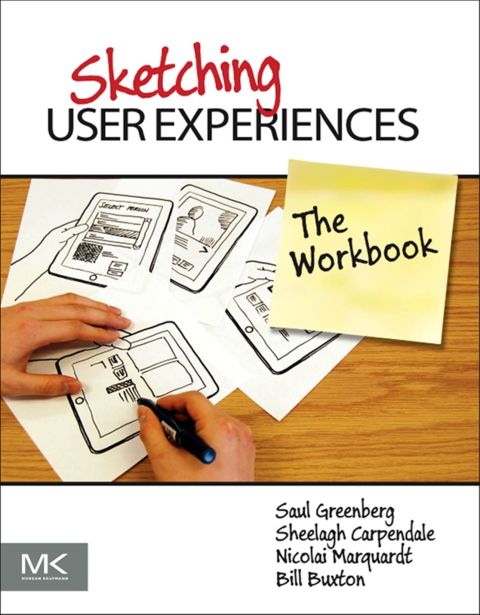Description
Efnisyfirlit
- Front Cover
- Sketching User Experiences
- Copyright Page
- Table of Contents
- Preface
- Acknowledgments
- Section 1: Getting into the Mood
- 1.1 Introduction
- Mission
- What this book is about
- Companion Book
- Why Sketch?
- Audience
- Structure of this Book
- 1.2 Why Should I Sketch?
- Sketching is About Design
- Getting the Design Right
- Elaboration and Reduction
- The Design Funnel
- The Product View
- You NowKnow
- 1.3 The Sketchbook
- Why a Sketchbook?
- Uses of a Sketchbook
- Best Practices
- Properties of Good Sketchbooks
- You Now Know
- 1.4 10 Plus 10: Descending the Design Funnel
- The 10 Plus 10 Method
- Design Challenge 1: Connecting Two Smart Phones
- Design Challenge 2
- Design Challenge 3
- You Now Know
- Section 2:Sampling the Real World
- 2.1 Scribble Sketching
- Capturing Ideas in Existing Systems
- Scribble sketching in the dark,While doing other things
- Practicing Scribble Sketching
- You Now Know
- 2.2 Sampling with Cameras
- Sampling Objects That Irritate You and Others
- Sampling Compelling Designs
- Sampling Things That Inspire You
- You Now Know
- 2.3 Collecting Images & Clippings
- Developing Your Collection
- Examples of Collections
- You Now Know
- 2.4 Toyboxes and Physical Collections
- Part One: Collecting Objects as Idea Triggers
- Collecting Objects to Build With
- Part Two: Storing Objects
- Part Three: Curating Your Objects
- Case Study: The Buxton Collection
- You Now Know
- 2.5 Sharing Found Objects
- Managing Sharing/Privacy Issues Around Sketching and Collecting
- You Now Know.
- Section 3: The Single Image
- 3.1 Warm Up to Sketching
- An Exercise in Line Quality
- Variations
- You Now Know
- 3.2 Sketching What You See
- An Excercise in Drawing What You See
- Part 1: Drawing From Your Imagination
- Part 2: Copy a Drawing of a Person
- Part 3: Drawing What You Actually See
- Comparing the Results
- You Try
- You Now Know
- 3.3 Sketching Vocabulary
- You Now Know
- 3.4 The Vanilla Sketch
- The Drawing
- Annotations
- Notes
- You Now Know
- 3.5 The Collaborative Sketch
- Gestures: Sketching With Others
- You Now Know
- 3.6 Slideware for Drawing
- Sketching in Slideware
- Digital vs Paper-Based Sketching
- Digital Collaboration
- You Now Know
- 3.7 Sketching with Office Supplies
- The Versatile Sticky Note
- Interacting with Office Supplies Over Time
- Using Office Supplies with Others
- You Now Know
- 3.8 Templates
- Appropriating Photos
- Tracing
- More on Layers
- Back to Paper
- Another Example: A Web Page Template
- You Now Know
- 3.9 Photo Traces
- Creating a Photo Trace
- Using the Photo Traces
- You Now Know
- 3.10 Hybrid Sketches
- You Now Know
- 3.11 Sketching with Foam Core
- Method 1: Sketching a Novel Interface or a Digital Watch
- Method 2: Using Photos to Prototype Existing Devices
- You Now Know
- Section 4: Snapshots in Time: The Visual Narrative
- 4.1 Sequential Storyboards
- The Sequential Storyboard
- You Now Know
- 4.2 The State Transition Diagram
- A Storyboard as States and Transitions
- Transition Diagram with Branches
- You Now Know
- 4.3 The Branching Storyboard
- The Cell Phone Example
- The Interactive Shopping System Example
- You Now Know
- 4.4 The Narrative Storyboard
- A Vocabulary of Camera Shots and Film Making
- Method 1: Sketching Storyboards
- Method 2: Photo-Based Storyboards
- You Now Know
- Section 5: Animating the User Experience
- 5.1 The Animated Sequence
- The Slide Show
- The Registration Problem
- The Solution: Registering Images
- You Now Know
- 5.2 Motion Paths
- You Now Know
- 5.3 Branching Animations
- Selecting Alternative Interaction Paths Through Hyperlinks
- You Now Know
- 5.4 Keyframes and Tweening
- Some Definitions
- Example: Adobe Flash
- You Try
- You Now Know
- 5.5 Linear Video
- Preparation
- Recording The Movie
- Variations: Paper and Transparency
- You Now Know
- Section 6: Involving Others
- 6.1 Uncovering the Initial Mental Model
- Uncovering The Mental Model
- You Now Know
- 6.2 Wizard of Oz
- Example 1: The Listening Typewriter
- Example 2: Robotic Interruption
- Example 3: The Fax Machine
- You Now Know
- 6.3 Think Aloud
- Steps of Think Aloud
- You Now Know
- 6.4 Sketch Boards
- Preparation Method 1: Foam Core Poster Sheets
- Preparation Method 2: Sticky Notes And Whiteboards
- Share Your Sketches with Others
- You Now Know
- 6.5 The Review
- The Elevator Pitch
- The Desktop Review
- The Meeting
- The Formal Review (or the Crit)
- You Now Know
- Index







Reviews
There are no reviews yet.